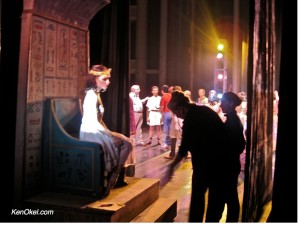 How do you react when a mistake happens in front of your customers? Too often, we reach for the panic button.
How do you react when a mistake happens in front of your customers? Too often, we reach for the panic button.
I received a lesson in dealing with mistakes from the sixth row of a theater. At the time, I was the Executive Director of a professional ballet company, watching our final performance of Cleopatra. This was a lavish show that had received overwhelming positive reviews.
I imagined the final performance as a validation of the company’s dedication to such a complex production. The large set pieces could be changed during an act, allowing seamless transitions between scenes. By the final production, I knew the timing perfectly.
 Midway through the first act, I knew that something was wrong when a large piece of scenery wasn’t moving from backstage right to offstage. It was on wheels and a couple of good tugs should allow the offstage stagehands to make it disappear.
Midway through the first act, I knew that something was wrong when a large piece of scenery wasn’t moving from backstage right to offstage. It was on wheels and a couple of good tugs should allow the offstage stagehands to make it disappear.
But something was caught on the wheel and it wasn’t moving. Instead of pulling it from offstage, a stagehand had to enter the performing area to give the scenery a good shove. It was a 15 to 20 second delay that felt like an eternity to me.
In my mind, the performance is probably ruined. The technical breakdown had spoiled the illusion. With any live show, you have one chance to make an impression.
Then I realized something: The audience hadn’t noticed the problem. How could they miss such an obvious mistake? The answer is that the company (with the exception of a flustered Executive Director) was prepared for mistakes.
It all happened in a few seconds:
- The stagehands wear black so it’s harder to notice them onstage
- They didn’t panic and calmly walked out and moved the scenery as if there wasn’t a problem
- The floor manager had the dancers hold for a couple of moments before they started their next scene
- And during that time, the orchestra was able to smoothly stretch the music
- It also helped that the performance up to that point had been flawless and the audience was very engaged
 When the curtain fell on Cleopatra, not one audience member mentioned the stuck scenery. The only way people would have probably realized there was a technical glitch would have happened had I stood up and started apologizing to the crowd.
When the curtain fell on Cleopatra, not one audience member mentioned the stuck scenery. The only way people would have probably realized there was a technical glitch would have happened had I stood up and started apologizing to the crowd.
But there was no need for that and that’s an important thing for leaders to realize when encountering public mistakes. These are going to happen but does your team understand how to calmly move on?
As a leader, you may feel that you need to react, apologize, and panic whenever something goes wrong. But you could end up making things worse. To Clear the Path, remember that mistakes don’t need a spotlight. Solutions do.
Run potential customer service problems in your mind and make sure your team knows how to react to them. Like the members of the dance company, you want their training to take over when a problem arises.
Sometimes being an effective leader is about sitting back and letting your team perform.





